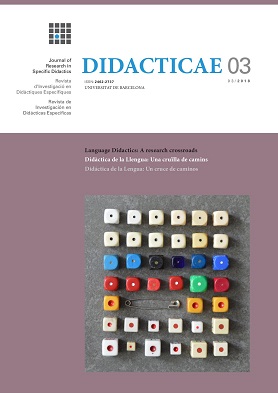Literacy practices among Spanish-Japanese children in Catalonia: An ethnographic study of their uses and attitudes toward them
DOI:
https://doi.org/10.1344/did.2018.3.16-34Keywords:
multilingual, heritage language, literacy practices and attitudesAbstract
This ethnographic study aims to analyze writing tasks, attitudes, roles and social practices of 11 students from grades one to nine who attend the Japanese Saturday school in Barcelona, Spain (Hoshuko Barcelona Educación Japonesa),in each of their four surrounding languages (Spanish, Catalan, English and Japanese). We conducted 22 interviews with their Japanese mothers and collected 32 students’ writing samples in multiple languages. Our participants have different language backgrounds because they belong to bilingual families and all go to local schools. In addition they all attend the Japanese school on Saturdays in order to maintain Japanese as a heritage language. We found that these children use four different languages both constantly and actively. With regard to Japanese, the most common literacy activity performed by them is keeping a diary, which is an assignment from their school. They occasionally write seasonal cards and send messages to their extended family in the appropriate language for the readers. From a sociocultural perspective, the literacy practices and the use of technology across the four languages were analyzed, with a special focus on the interactions and the appropriation of two significantly different writing systems (Spanish, Catalan and English versus Japanese).
References
Barton, D. (2010). Vernacular writing on the web. In D. Barton & U. Papen (Eds.), The anthropology of writing: Understanding textually mediated world, p. 109-125. London: Continuum.
Barton, D., & Hamilton, M. (1998). Local literacies: Reading and writing in one community. London: Routledge.
Cummins, J., Danesi, M., Nakajima, K., & Takagaki, T. (2005). Heritage languages. (In Japanese: Translation of J. Cummins & M. Danesi [1990]. Heritage languages: The development and denial of Canada’s linguistic resources). Tokyo: Akashi. Syoten.
Cassany, D. (2008). Prácticas letradas contemporáneas: Claves para su desarrollo. México: Ríos de Tinta.
Cassany, D. (2012). Foreign language reading from the point of view of new literacy studies. In P. Alderete-Díez, L. Incalcaterra, L. McLoughlin, N. Dhonnchadha & D. Ní Uigín (Eds.), Translation, technology and autonomy in language teaching and learning, p. 11-36. New York: Peter Lang.
Fukuda, M. (2010). Supervivència de la colònia japonesa a Catalunya: L’organització interna i la seva implicació en l’ecosistema lingüístic català. Revista de Llengua i Dret, 53, 213-241.
Fukuda, M. (2017). Language use in the context of double minority: the case of Japanese–Catalan/ Spanish families in Catalonia. International Journal of Multilingualism, 14(4), 401-418.
Gee, J. (1991). Social linguistics: Ideology in discourse. London: Falmer Press.
Gee, J. (2000). The New Literacy Studies; form “socially situated” to the work of the social. In D. Barton, M. Hamilton, & R. Ivanic (Eds.), Situated literacies: reading and writing in context, p. 180-196. Routledge: London.
Kalman, J. (2003). Access to literacy: Social participation and the appropriation of knowledge in daily reading and writing. Mexican Journal of Educational Research, 8(17), 37-66.
Kalman, J., & Street, B. (2010). Lectura, escritura y matemáticas como prácticas sociales. Diálogos con América Latina. México: Siglo XXI.
Heath, S. (1983). Ways with words: Language, life, and work in communities and classrooms. New York: Cambridge University Press.
Lankshear, C., & Knobel, M. (2006). New literacies: Everyday practices and classroom learning (2nd edition). Maidenhead and New York: Open University Press.
Martin-Jones, M., & Jones, K. (Eds.) (2000). Multilingual literacies: Comparative perspectives on research and practice. Amsterdam: John Benjamins.
Poveda, D., Palomares-Valera, M., & Cano, A. (2006). Literacy mediations and mediators in the escuela dominical of a Gitano Evangelist Church. Ethnography and Education Journal, 1(2), 256-283.
Poveda, D., & Sánchez, J. (2010). Las prácticas y estilos de literacidad de los adolescentes fuera de la escuela: Una exploración cuantitativa de las relaciones entre literacidad, escolarización y origen familiar. Sociolinguistic Studies, 4(1), 85-114.
Scriber, S., & Cole, M. (1981). The psychology of literacy. Cambridge, Mass.: Harvard University Press.
Street, B. (2003). What’s «new» in new literacy studies? Critical approaches to literacy in theory and practice. Current Issues in Comparative Education, 5(2), 77-91.
Zavala, V., & Córdova, G. (2010). Decir y callar. Lenguaje, equidad y poder en la universidad peruana. Lima: Pontificia Universidad Católica del Perú.
Downloads
Published
Issue
Section
License
Copyright (c) 2018 Didacticae: Journal of Research in Specific Didactics

This work is licensed under a Creative Commons Attribution-ShareAlike 4.0 International License.
The authors who publish in this journal agree to the following terms:
- Authors retain copyright and grant the journal the right of first publication.
- Submitting a paper does not involve paying any fees.
- Texts will be published under a Creative Commons Attribution Share-Alike 4.0 International License that allows others to share the work, provided they include an acknowledgement of the work’s authorship, its initial publication in this journal and the terms of the license.
- When citing works published in Didacticae, both the autor and the journal must be cited.
- Didacticae does not accept any responsibility for the points of view and statements made by the authors.



